Study on the Thermodynamic Properties of Concrete Surface during Microwave Deicing of Airport Pavement
Abstract
1. Introduction
2. Raw Materials and Specimen Preparation
2.1. Raw Materials
2.2. Specimen Preparation
3. Test Equipment and Test Method
3.1. Test Equipment
3.2. Test Method
- (1)
- The microwave source port is controlled to be 20 mm above the concrete surface, the concrete specimen is heated by microwave for 80 s, and the surface temperature of each measuring point is recorded every 5 s.
- (2)
- Simultaneously, the microwave source height of the device is adjusted to 20, 30, 50, 70, and 100 mm. The real-time temperature of each temperature measuring point is monitored and recorded every 5 s.
- (3)
- Subsequently, the height of the microwave source is fixed as 20 mm. The surface temperature distribution of concrete specimen covered with ice is investigated and compared with that of a non-ice specimen.
4. Test Results and Analysis
4.1. Variation Law of Concrete Surface Temperature During Microwave Heating
4.2. Temperature Distribution of Concrete Surface at Different Microwave Source Heights
4.3. Effect of Ice Layer on Temperature Distribution of Concrete Surface
5. Effect Mechanism of Microwave on Temperature Distribution of Concrete Surface
6. Conclusions
- (1)
- In the process of microwave deicing, the microwave effect directly leads to the linear rise of the surface distribution of pavement concrete, among which the temperature at the surface center point is the most obvious. The increasing amplitude of concrete surface temperature is centered on the center point and shows a stepwise decreasing trend along the radius.
- (2)
- The microwave thermal effect on concrete surface decreases with the increase of the microwave source height, but the uniformity of temperature distribution increases. When the height of microwave source is 20 mm, the irradiation blind area is generated, and the irradiation area is small, which reduces the effective range of microwave.
- (3)
- The ice coverage will directly affect the real-time temperature curve of concrete surface under the action of microwave. In the case of no ice layer coverage, the real-time temperature curve increases linearly, and the microwave effect on the concrete surface decreases with the increase of the distance between the temperature measuring point and the center point. While in the case of ice cover, the temperature increase can be divided into three stages with 0 °C as the reference point, all of which show an upward trend. The heating rate is in order from large to small: the stage above 0 °C, the stage below 0 °C, and the stage near 0 °C.
- (4)
- After the test, it is found that the surface temperature of airport pavement concrete can still be maintained above 0 °C after microwave deicing, and the retention time is 10 min. This phenomenon is defined as residual heat in the microwave deicing process, which can effectively delay the process of ice layer refreezing on the concrete surface.
Author Contributions
Funding
Conflicts of Interest
References
- China Meteorological Society. Meteorological science and social and economic sustainable development. In Proceedings of the 2005 Annual Meeting of China Meteorological Society, Hong Kong, China, 22–25 November 2005; China Meteorological Press: Bejing, China, 2005. [Google Scholar]
- Xu, H.F.; He, Z.Y.; Zhu, Y.Z.; Zhao, X.L. Current situation and development trend of road deicing and snow removal vehicles. Spec. Purp. Veh. 2018, 7, 83–86. [Google Scholar]
- Zhuang, T. Research on Key Components and Thickness Detection of Solid Ice and Snow Removal; Jiamusi University: Jiamusi, Heilongjiang, China, 2016. [Google Scholar]
- Tao, L. Comparison of advantages and disadvantages of snow melting agent and its substitute materials. China Highw. 2018, 3, 64–65. [Google Scholar]
- Xie, Y.C.; Weng, X.Z.; Zhang, J.; Wan, X.C.; Gao, Q. Study on salt frost erosion of pavement concrete in saline soil area. Highw. Transp. Technol. 2017, 34, 25–31. [Google Scholar]
- Alimrani, N.S.; Balazs, G.L. Synthetic fibres or fibre cocktail in terms of shear capacity of concrete after elevated temperatures. Mech. Mater. 2020, 148, 103504. [Google Scholar] [CrossRef]
- Alimrani, N.S.; Balazs, G.L. Investigations of direct shear of one-year old SFRC after exposed to elevated temperatures. Constr. Build. Mater. 2020, 254, 119308. [Google Scholar] [CrossRef]
- Kodur, V.; Banerji, S.; Solhmirzaei, R. Test methods for characterizing concrete properties at elevated temperature. Fire Mater. 2019, 44, 381–395. [Google Scholar] [CrossRef]
- Kodur, V.; Banerji, S.; Solhmirzaei, R. Effect of Temperature on Thermal Properties of Ultrahigh-Performance Concrete. J. Mater. Civ. Eng. 2020, 32, 04020210. [Google Scholar] [CrossRef]
- Qunying, M.; Li, X.-J. Application and research progress of microwave heating technology. Physics 2004, 33, 438–442. [Google Scholar]
- Buchta, R.; Böling, G.; Sellberg, F.; Sigurd, D. Microwave Heating for VLSI Processing. In Proceedings of the 22nd European Microwave Conference, Helsinki, Finland, 5–9 September 1992; Institute of Electrical and Electronics Engineers (IEEE): Piscataway, NJ, USA, 1992; Volume 1, pp. 34–46. [Google Scholar]
- Wang, J.; Wang, Y. Principle and application of microwave heating. J. Jilin Norm. Univ. Nat. Sci. 2012, 33, 142–144. [Google Scholar]
- Woodhouse, I.H. Introduction to Microwave Remote Sensing; Science Press: Beijing, China, 2014. [Google Scholar]
- Zanko, L.M.; Fosnacht, D.R.; Hopstock, D.M. Construction aggregate potential of Minnesota taconite industry byproducts. In Cold Regions Engineering 2009: Cold Regions Impacts on Research, Design, and Construction; ASCE: Reston, VA, USA, 2009; pp. 252–274. [Google Scholar]
- Hopstock, D.M.; Zanko, L.M. Minnesota Taconite as a Microwave-Absorbing Road Aggregate Material for Deicing and Pothole Patching Applications Final Report; Applications Final Report; Minnesota Department of Transportation Research Services Section: Minneapolis, MN, USA, 2005. [Google Scholar]
- Gallego, J.; Del Val, M.A.; Contreras, V.; Páez, A. Heating asphalt mixtures with microwaves to promote self-healing. Constr. Build. Mater. 2013, 42, 1–4. [Google Scholar] [CrossRef]
- Wang, C.; Yang, B.; Tan, G.; Guo, X.; Zhou, L.; Xiong, S. Numerical analysis on thermal characteristics and ice melting efficiency for microwave deicing vehicle. Mod. Phys. Lett. B 2016, 30, 1650203. [Google Scholar] [CrossRef]
- Gao, J.; Guo, H.; Wang, X.; Wang, P.; Wei, Y.; Wang, Z.; Huang, Y.; Yang, B. Microwave deicing for asphalt mixture containing steel wool fibers. J. Clean. Prod. 2019, 206, 1110–1122. [Google Scholar] [CrossRef]
- Chaopeng, K. Effect of Microwave on Deicing Efficiency and Durability of Pavement Cement Concrete; Harbin Institute of Technology: Harbin, Heilongjiang, China, 2019. [Google Scholar]
- Liu, J.-L.; Xu, J.-Y.; Lu, S.; Chen, H. Investigation on dielectric properties and microwave heating efficiencies of various concrete pavements during microwave deicing. Constr. Build. Mater. 2019, 225, 55–66. [Google Scholar] [CrossRef]
- Liu, J.-L.; Jin-Yu, X.; Huang, H.; Chen, H. Microwave deicing efficiency and dielectric property of road concrete modified using different wave absorbing material. Cold Reg. Sci. Technol. 2020, 174, 103064. [Google Scholar] [CrossRef]
- Wang, S.T.; Ma, G.J.; Zhu, Z.Y.; Liu, X.X.; Wu, Y.G.; Dun, X. Mix design of high performance pavement concrete. J. Highw. Transp. Res. Dev. 2007, 24, 25–28. [Google Scholar]
- Pennisi, C.P.A.; Leija, L.; Fonseca, W.H.; Vera, A. Fiber optic temperature sensor for use in experimental microwave hyperthermia. In Proceedings of the Sensors, Orlando, FL, USA, 12–14 June 2002; Institute of Electrical and Electronics Engineers (IEEE): Piscataway, NJ, USA, 2002. [Google Scholar]
- Saltiel, C.; Datta, A.K. Heat and Mass Transfer in Microwave Processing. Advances in Heat Transfer; Elsevier: Amstertam, The Netherlands, 1999; Volume 33, pp. 1–94. [Google Scholar]
- Mishra, R.R.; Sharma, A.K. Microwave-material interaction phenomena: Heating mechanisms, challenges and opportunities in material processing. Compos. Part A Appl. Sci. Manuf. 2016, 81, 78–97. [Google Scholar] [CrossRef]
- Yang, G.; Kong, Y.; Hou, W.; Yan, Q. Heating Behavior and Crystal Growth Mechanism in Microwave Field. J. Phys. Chem. B 2005, 109, 1371–1379. [Google Scholar] [CrossRef] [PubMed]
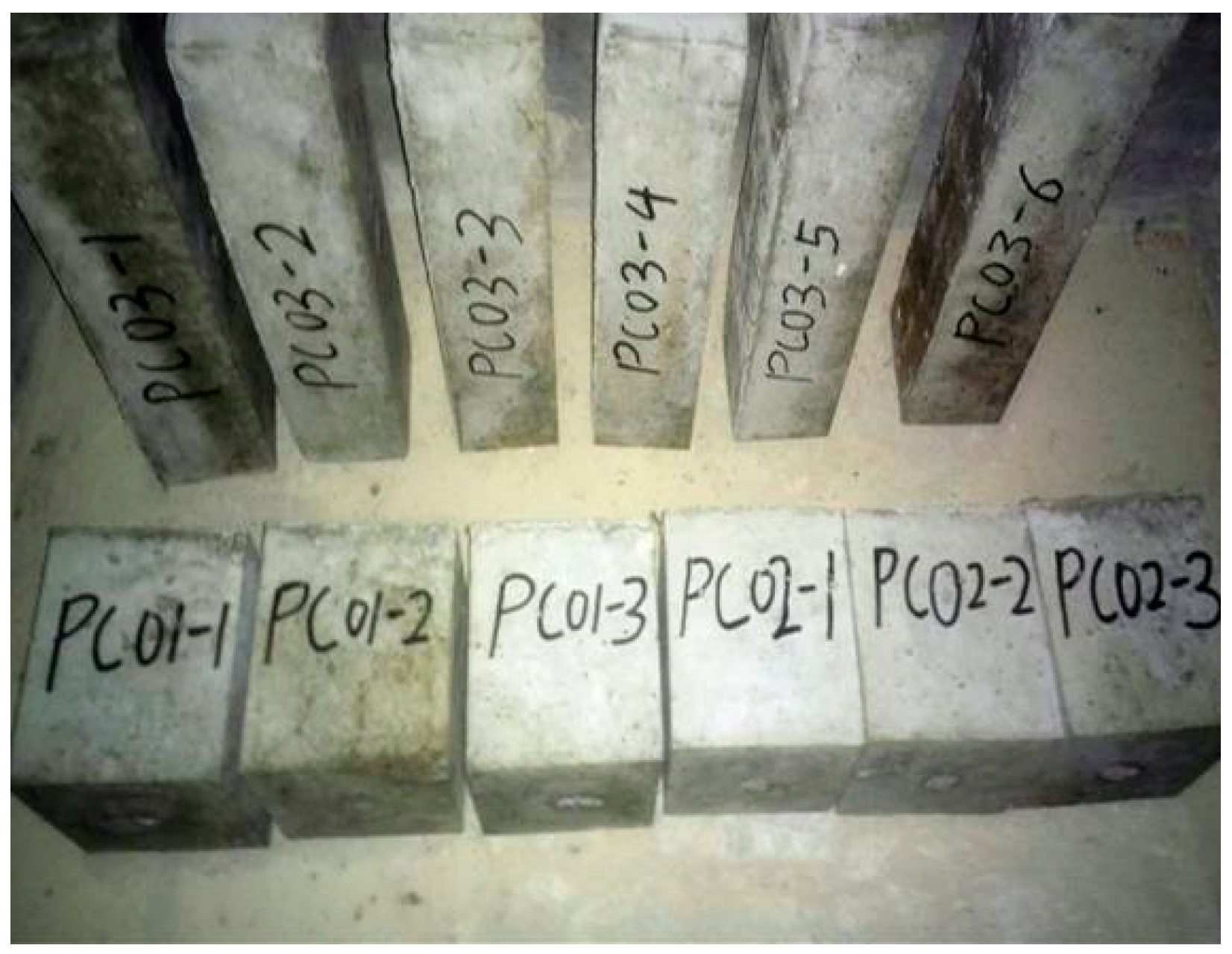

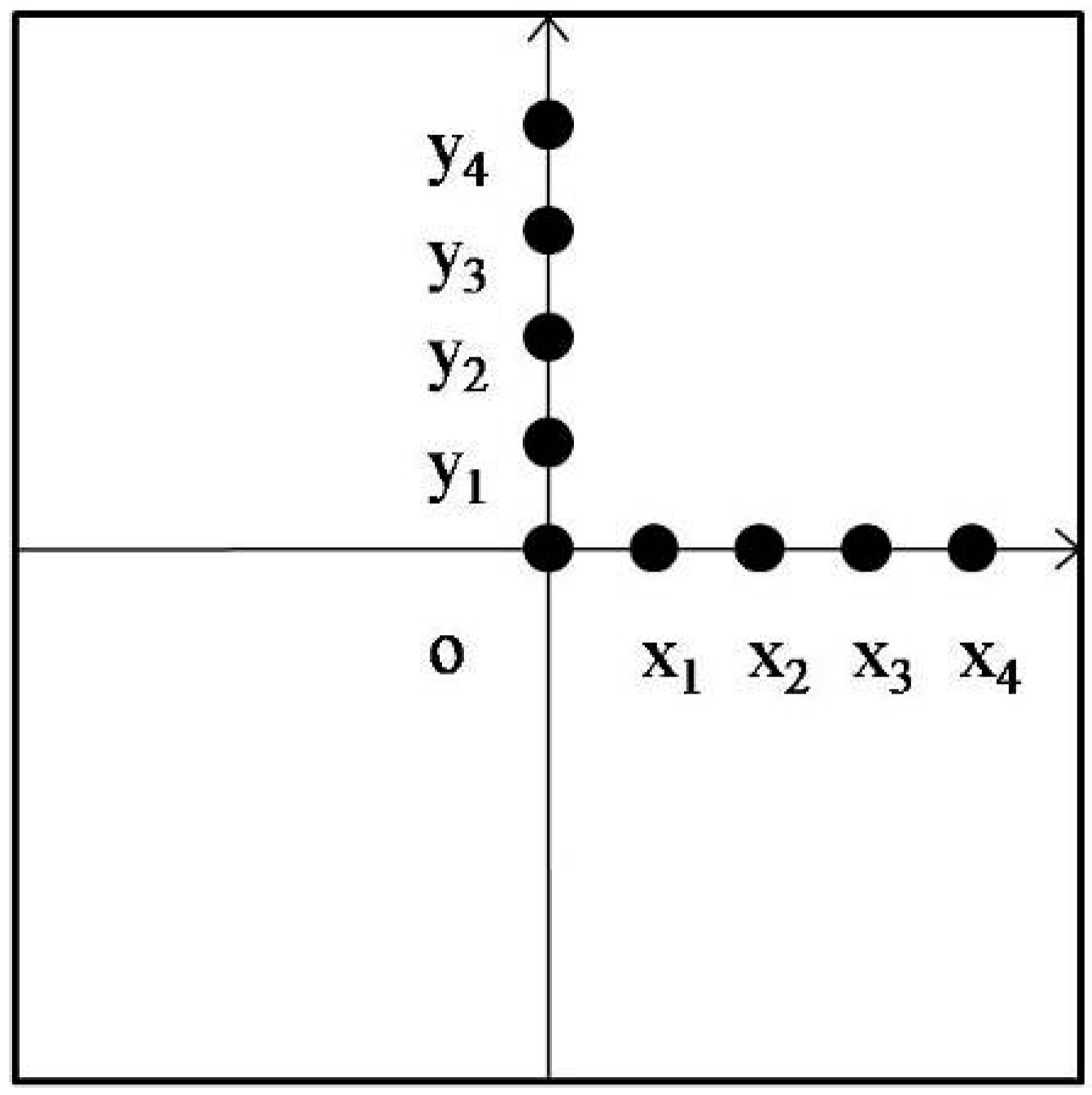
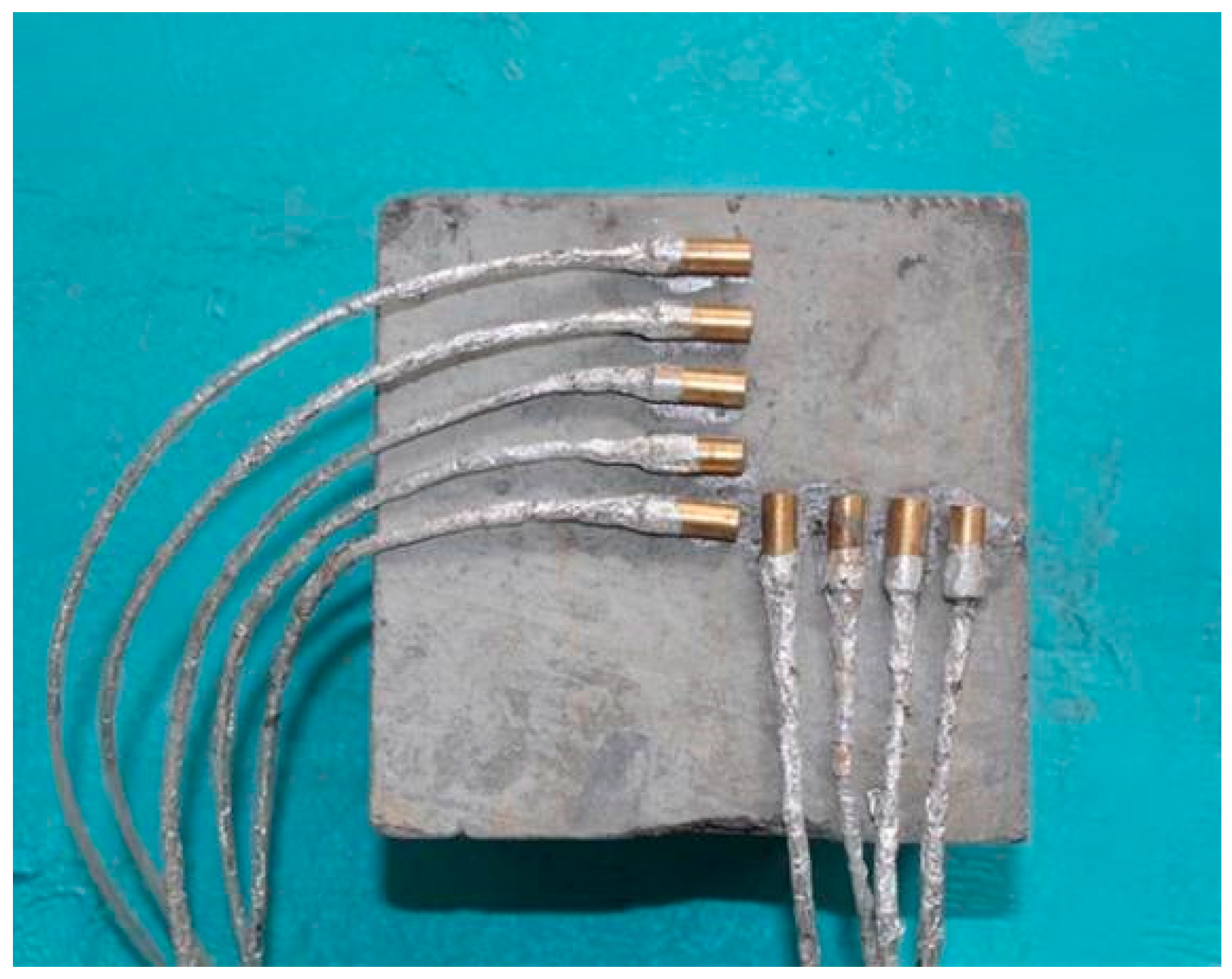
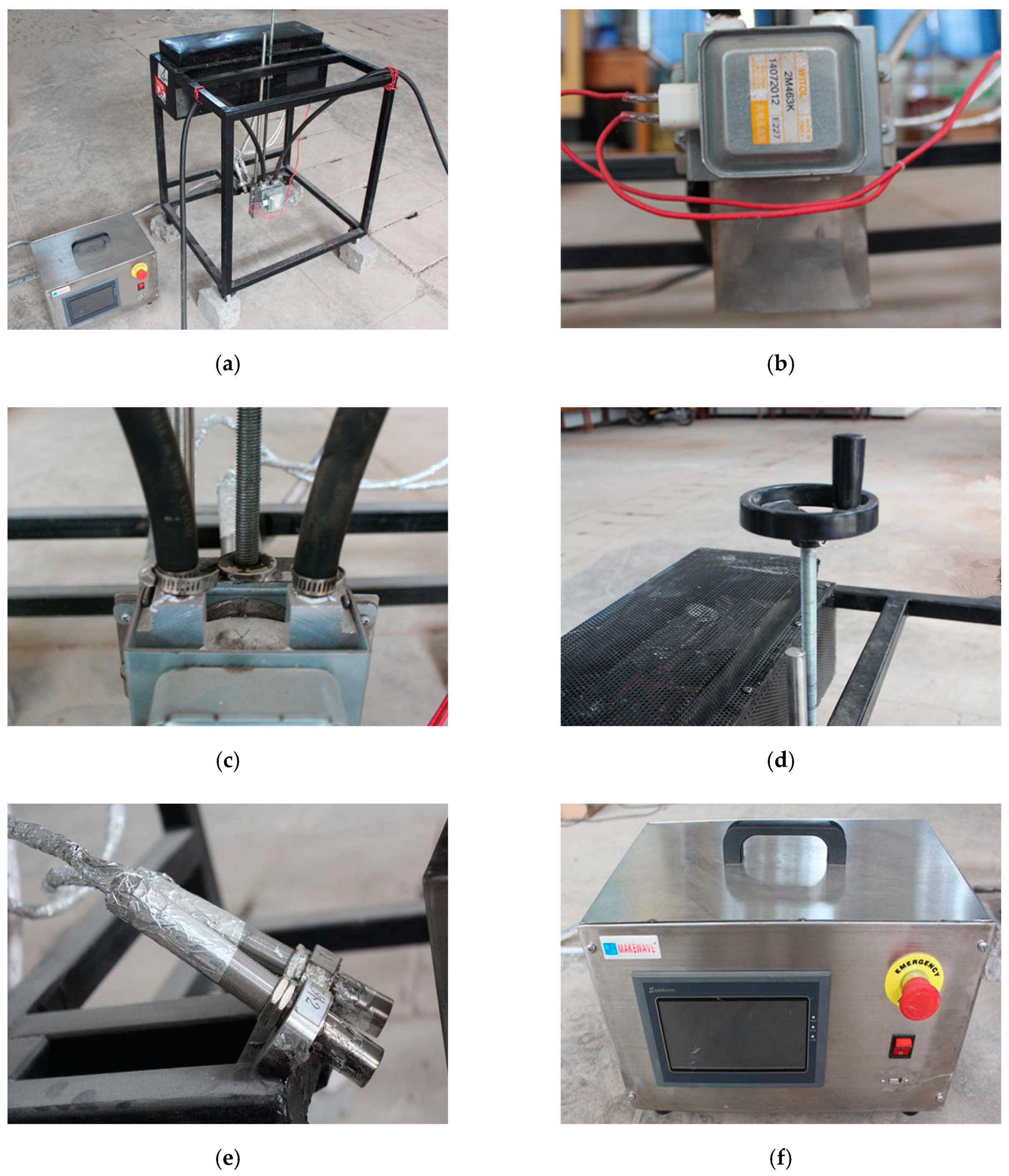
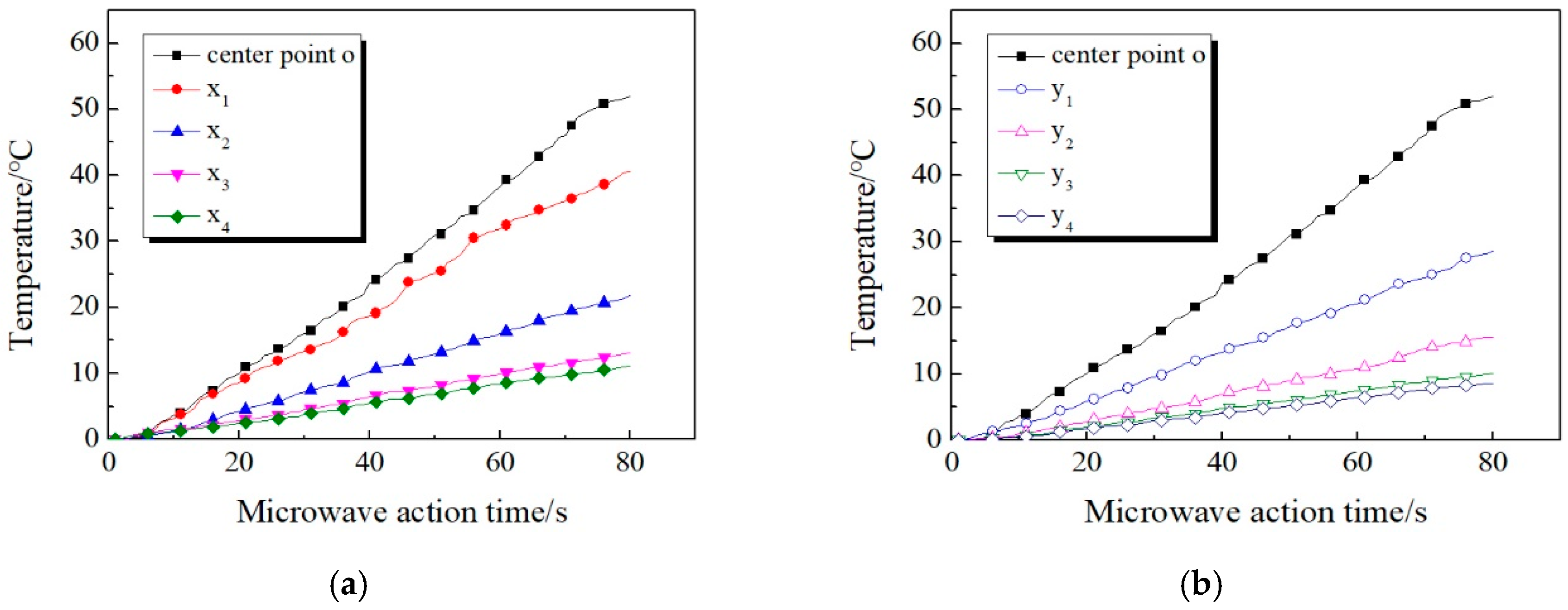
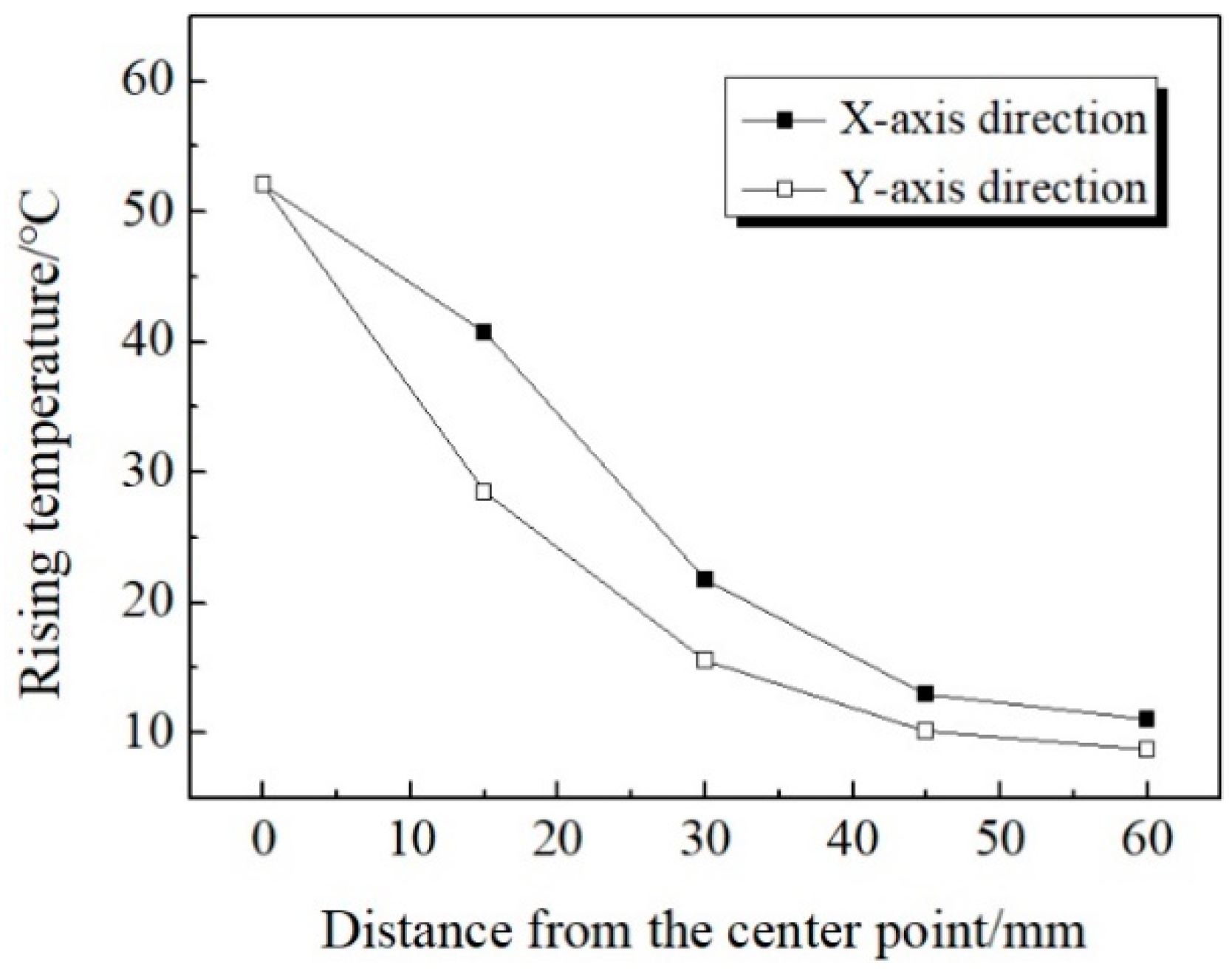

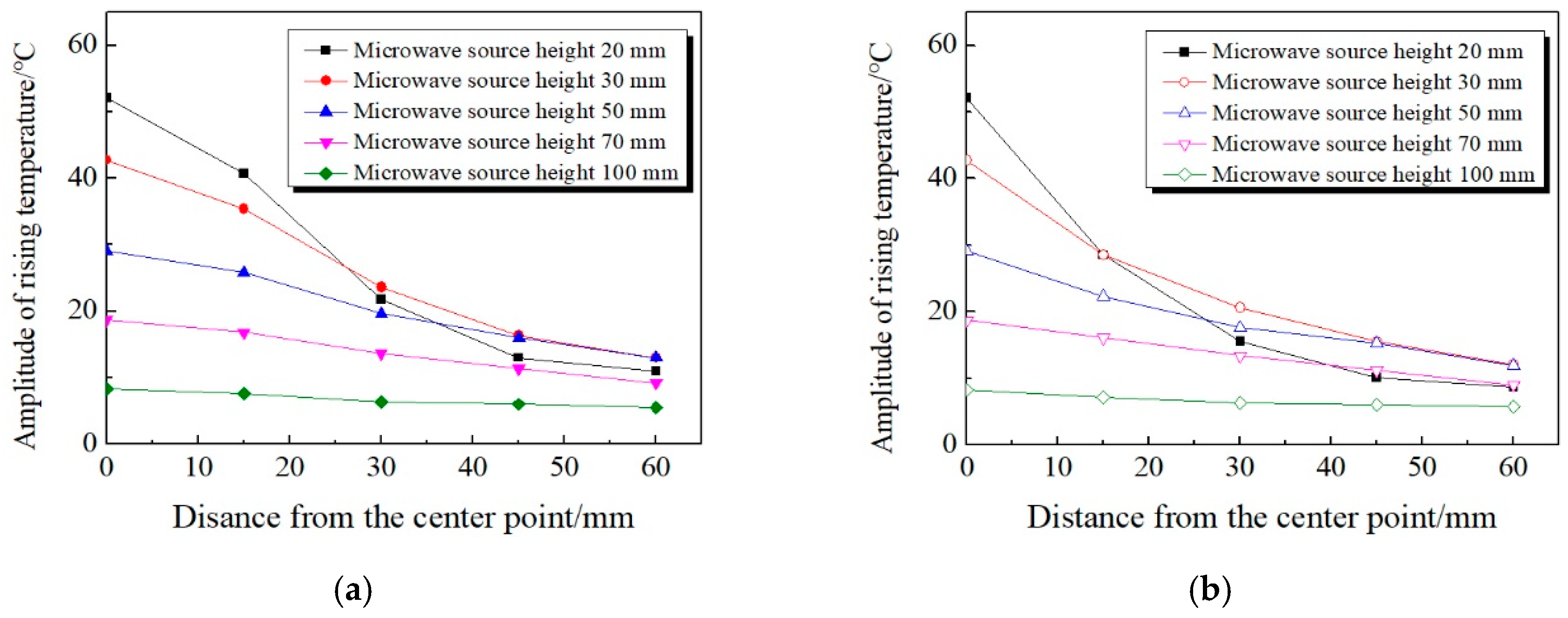
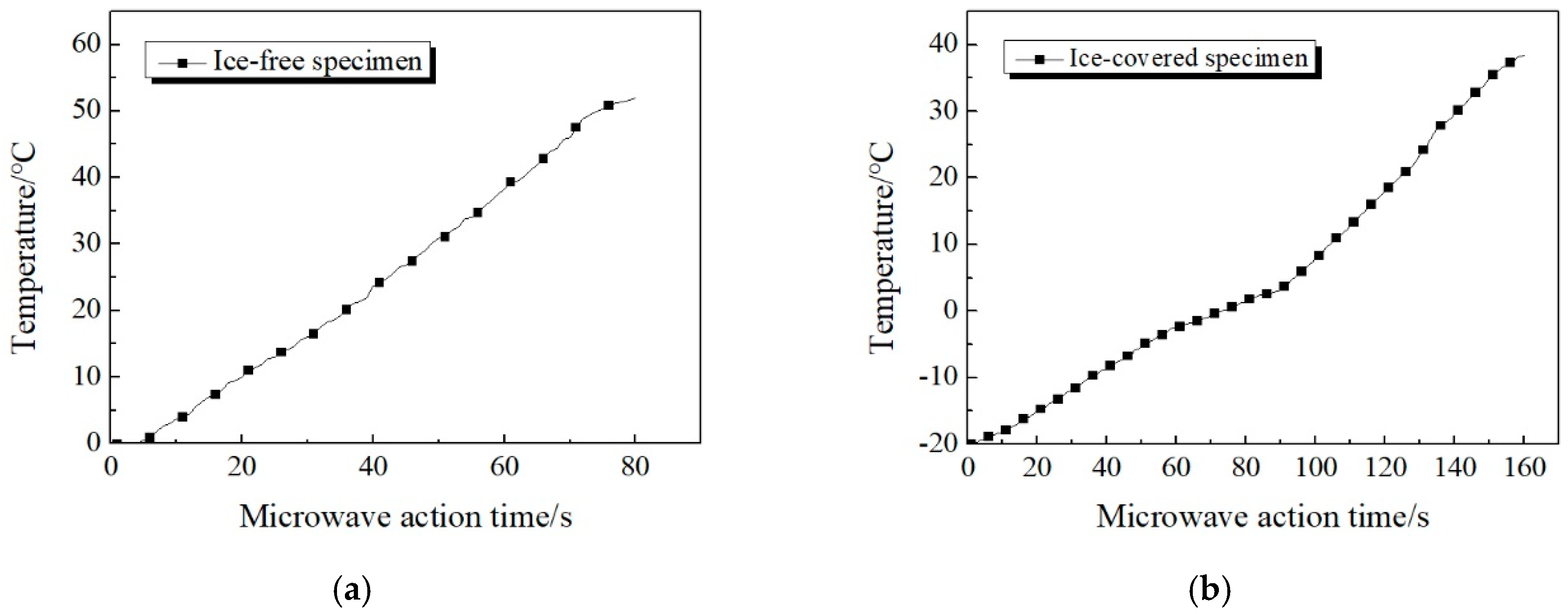

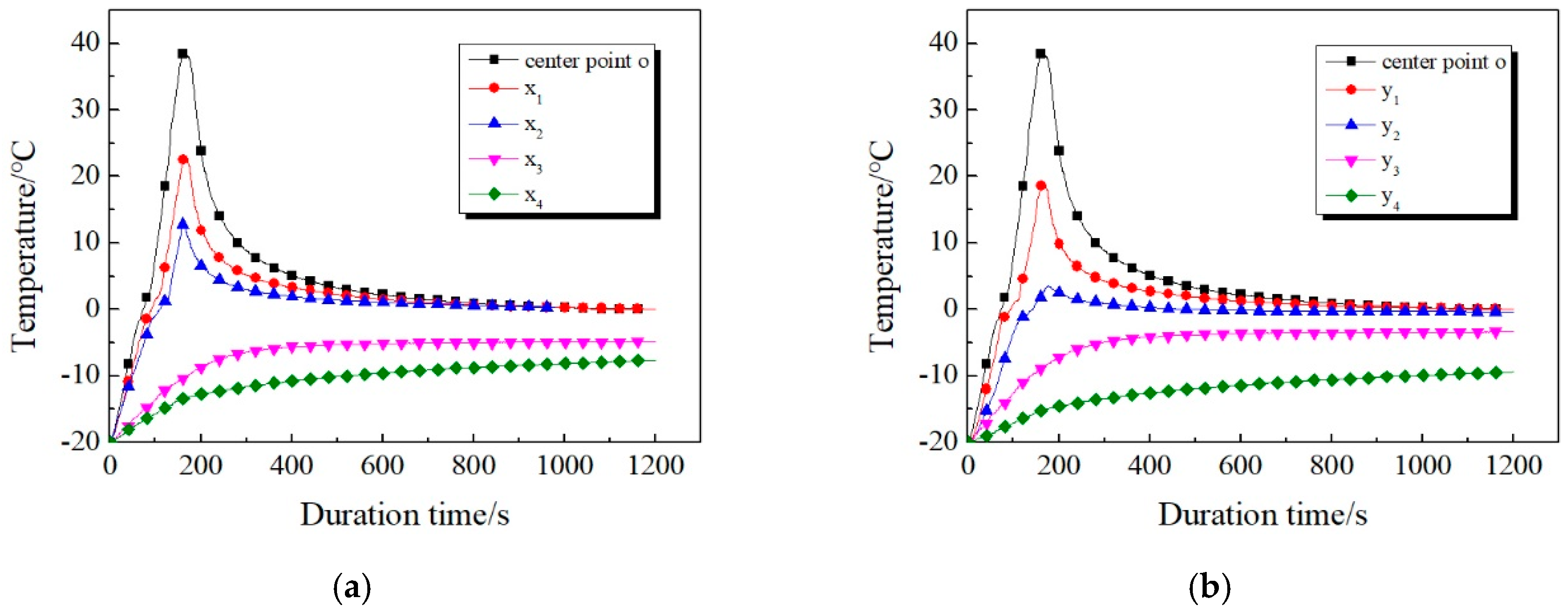

| Material Consumption Per m3 of Concrete (kg) | Cement | Water | Large Stone | Medium Stone | Small Stone | Sand | Water-Reducing Agent |
| 330 | 135 | 575 | 575 | 287.5 | 562.5 | 3.63 |
| Measuring Point | o | x1 | x2 | x3 | x4 | y1 | y2 | y3 | y4 |
|---|---|---|---|---|---|---|---|---|---|
| Temperature increase time (s) | 20 | 22 | 39 | / | / | 31 | 55 | / | / |
© 2020 by the authors. Licensee MDPI, Basel, Switzerland. This article is an open access article distributed under the terms and conditions of the Creative Commons Attribution (CC BY) license (http://creativecommons.org/licenses/by/4.0/).
Share and Cite
Chen, H.; Xu, J.; Wu, Y.; Liu, J.; Huang, H. Study on the Thermodynamic Properties of Concrete Surface during Microwave Deicing of Airport Pavement. Materials 2020, 13, 3557. https://doi.org/10.3390/ma13163557
Chen H, Xu J, Wu Y, Liu J, Huang H. Study on the Thermodynamic Properties of Concrete Surface during Microwave Deicing of Airport Pavement. Materials. 2020; 13(16):3557. https://doi.org/10.3390/ma13163557
Chicago/Turabian StyleChen, Haowen, Jinyu Xu, Yunquan Wu, Junliang Liu, and He Huang. 2020. "Study on the Thermodynamic Properties of Concrete Surface during Microwave Deicing of Airport Pavement" Materials 13, no. 16: 3557. https://doi.org/10.3390/ma13163557
APA StyleChen, H., Xu, J., Wu, Y., Liu, J., & Huang, H. (2020). Study on the Thermodynamic Properties of Concrete Surface during Microwave Deicing of Airport Pavement. Materials, 13(16), 3557. https://doi.org/10.3390/ma13163557





